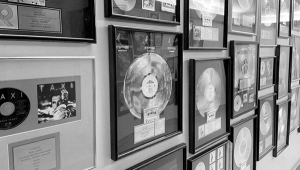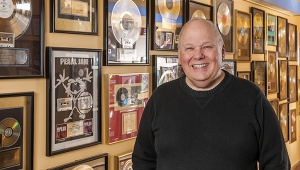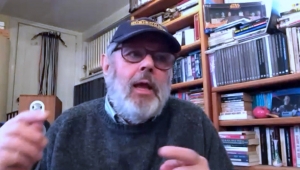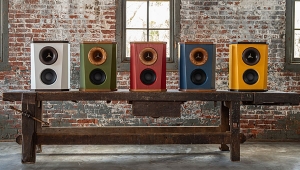| Columns Retired Columns & Blogs |
Jim Fosgate: Of (Surround) Sound Mind
Jim Fosgate fits the category of Classic American Inventor to a T. This softspoken, quietly intense man has earned 18 patents and founded three successful electronics companies. In the late 1970s, he pulled out of the car audio business to follow his quadraphonic bliss, and designed the Fosgate Tate 101, arguably the finest quad decoder of the era. He also created the best-selling matrix surround processor of all time, Dolby's Pro Logic II, and in 2003 won an Emmy for the Development of Surround Sound for Television. He now serves as a senior executive consultant for Fosgate Audionics, a division of the Rockford Corporation.
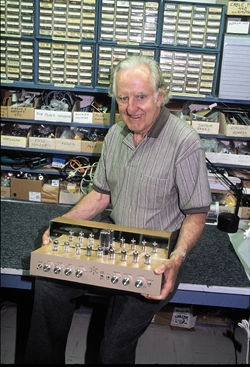 In early June 2004, I visited Jim Fosgate and his wife, Norma, at their home in Heber, Utah—I just had to see and hear first-hand his hand-built, all-tube system. Listening exclusively to stereo recordings bumped up to multichannel, I was floored by the scale of the velvety-rich, palpably textured sound. When I noted the presence of a ceiling-mounted video projector, Fosgate just chuckled, waving aside any possibility that he's a home-theater fan. No way—he happily spends his days exploring the music on his 5000 LPs and 2000 CDs. Our listening sessions stretched out for hours as one LP led to the next, from Glenn Miller to the Moody Blues to Pink Floyd to Ray Conniff. We talked in Fosgate's lab, just a few steps away from his music system.
In early June 2004, I visited Jim Fosgate and his wife, Norma, at their home in Heber, Utah—I just had to see and hear first-hand his hand-built, all-tube system. Listening exclusively to stereo recordings bumped up to multichannel, I was floored by the scale of the velvety-rich, palpably textured sound. When I noted the presence of a ceiling-mounted video projector, Fosgate just chuckled, waving aside any possibility that he's a home-theater fan. No way—he happily spends his days exploring the music on his 5000 LPs and 2000 CDs. Our listening sessions stretched out for hours as one LP led to the next, from Glenn Miller to the Moody Blues to Pink Floyd to Ray Conniff. We talked in Fosgate's lab, just a few steps away from his music system.
Steve Guttenberg: Let's see...you grew up in Indianapolis, where your dad owned a TV repair shop.
Jim Fosgate: Yes, my father was an experimenter, and he got into TV early on. He built our first television from parts, along with an antenna that could receive signals from Chicago and Cincinnati. We had the first TV set in Indianapolis, and I worked in his shop and did repairs.
Guttenberg: So you were probably just a little kid when you started building gear.
Fosgate: I started playing around with electronics when I was seven or eight. I didn't know what I was doing then, but when I was 12 I put a radio on my bicycle.
Guttenberg: A tube radio?
Fosgate: It was quite a hoot—I used a 2V storage battery with a step-up high-voltage power supply, a big tube radio, a long whip antenna, and I fastened a speaker to the center of the handlebars. It was very cool. I got a lot of funny looks for that one. When I bought my first car, a 1946 or '47 Chevy, I built a bass-reflex speaker in the rear deck. Later, I installed an open-reel tape system in my '63 Chevy.
Guttenberg: Your collection of vintage audio gear is the biggest and best I've ever seen. When did you start lugging this stuff home?
Fosgate: In the mid-'70s, a friend of mine took me around to garage sales and swap meets. You could pick up tube gear for next to nothing, and since I was afraid tubes were going away, I bought a lot of stuff. I couldn't have imagined the tube resurgence that took off later in the decade.
Guttenberg: Do you ever hook up any of the pieces?
Fosgate: Sure, for fun. And when I'm designing tube gear, it's nice to listen to these old units; they represent the history of audio. I've restored some of them, but now that I have so many I can't keep up.
Guttenberg: When did you get into surround sound?
Fosgate: I was the president of my car-audio company, Fosgate Electronics, and in 1977 I decided to move into multichannel home audio—it was way too early for surround in the car. That's just now starting to take off, so you could say I was 27 years too early. I had been an avid quad listener for quite a few years.

Guttenberg: Except that, by the late '70s, quad was a lost cause.
Fosgate: But it was something I believed in, and I knew I could do a good job with it, but it was an uphill battle. When I started working on the Fosgate Tate 101 surround decoder, the audio retailers didn't want it and the magazines weren't interested. It took a long time to break through.
Guttenberg: I'd say—but you have to admit, the confusion over LP surround formats was more than partially responsible for the public's rejection of quad.
Fosgate: There were four formats—Columbia had SQ, Sansui had QS, Electro Voice had EV-4, JVC had CD-4—but they weren't compatible. Quadraphiles needed a separate decoder for each format. They all had their problems. With CD-4, it was hard to find a phono cartridge that tracked well enough not to break up. The open-reel recordings were really good, and they had discrete separation, but the vast majority of material was only available on matrixed LPs. When quad died, we had no choice but to make our processor work with stereo recordings.
Guttenberg: Matrix? We're not referring to Keanu Reeves' Matrix, are we?
Fosgate: Matrix refers to the circuit topography: two channels go in and are mixed to provide five outputs. As you can imagine, you don't get something for nothing—you start out with high separation between the input stereo channels, but you wind up with very poor separation between the output channels, and have to employ some means of increasing channel separation.
Guttenberg: Your very first matrix decoder, the Fosgate Tate 101, is still sought after by quaddies.
Fosgate: When we took it to [the Consumer Electronics Show] in Las Vegas in 1979, we didn't get a single order. Boy, were we bummed. Quad was in big trouble by then, but later that year we did a demonstration at Jerry's Audio in Phoenix with a Kloss video projector—and that clicked. We used video at the next CES, and our room was always full. By that time quad had such a negative connotation we came up with a new term, "surround sound," to describe our sound.
Guttenberg: Were you familiar with David Hafler's DynaQuad box?
Fosgate: Yes, but at its best, it didn't have precise imaging or localization—its separation was poor. You see, it's a passive system. You can't do a lot with that approach; without active steering logic, you're limited, but I thought it sounded better than stereo.
Guttenberg: Let's jump ahead to your latest achievement, the Dolby Pro Logic II matrix surround processor. How does it work?
Fosgate: PLII analyzes the signal content and generates anti-phase signals, which are applied to the matrix to cancel the crosstalk between the other channels. I designed it to work with movies and normal stereo recordings. It produces a very natural effect.
Guttenberg: Nowadays, I assume you do all of your design work on a computer.
Fosgate: No, not at all. I'm an empirical, seat-of-the-pants type of engineer—I fiddle around with something, listen, and go from there. In the beginning you have no clue, but you learn how to listen—listen to the accuracy of the soundstage, how wide and deep—while also listening for artifacts and anomalies that are mixed in with the sound.
Guttenberg: What sort of artifacts?
Fosgate: Intermodulation distortion, pumping and breathing, wobbles and plops.
Guttenberg: Huh?
Fosgate: We had all sort of names for the artifacts. You have to become a very, very critical listener, so much so it became difficult to listen for pleasure to my early surround decoders. You learn what the ear tolerates and what it doesn't like. You keep coming up with circuitry that takes all of that into account. It's a psychoacoustic phenomenon—you're trying to fool the ear into accepting that you're listening to five separate channels. For years, I felt like I was trying to defy the laws of physics.
Guttenberg: Gee, how did you maintain concentration over the months while you were working out the details of PLII?
Fosgate: Sometimes when I hit a snag, I'd dart off and work on my tube phono preamp to let my mind rest. Over the years, I've probably built something like 120 phono-preamp circuits. Breaking away from surround design and building something was therapeutic for me.
Guttenberg: How so?
Fosgate: I believe our subconscious mind works out most of the details, and we may even tap into something else in the universe and the design comes through us. I designed the core elements of PLII over a nine-month period, and most of the breakthroughs would come when I'd wake up in the middle of the night—and then I'd work the details. It drove my wife crazy. Norma said my brain was generating so much energy she couldn't sleep in the same room with me!
- Log in or register to post comments

